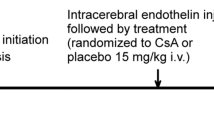Abstract
Reperfusion injury is believed to contribute to the pathophysiology of ischemic cell death, but the precipitating factors have yet to be completely elucidated. The goal of this study was to examine if reflow-induced secondary energy failure is a component in the events that lead to cell death following increasing periods of middle cerebral artery (MCA) occlusion in Wistar rats. Discrete sections within the MCA distribution were dissected and analyzed for high-energy phosphates and glucose. Regional cerebral blood flow was determined by [14C]-iodoantipyrine technique in representative groups. The levels of ATP + P-creatine were initially depressed at the end of the focal ischemia and the concentrations in the penumbra were unchanged for up to 8 h after 2 h of ischemia which contrasts with response in the ischemic core, striatum, and penumbra where the HEP generally recovered to values near those of control only to decrease with increasing periods of reflow. The possibility of a rebound ischemia in secondary energy failure (SEF) was precluded by regional CBF values and concentrations of glucose that were significantly higher than the threshold for an ischemic effect. The depletion of cellular energy stores following SEF strongly indicates that the evolution of infarct during reflow results from loss of ATP and its synthesis.
Similar content being viewed by others
REFERENCES
Barrientos, A., and Moraes, C. (1999). Titrating the effects of mitochondrial Complex I impairment in the cell physiology. J. Biol. Chem. 274:16188–16197.
Bolanos, J.P., Almeida, A., Stewart, V., Peuchen, S., Land, J.M., Clark, J.B., and Heales, S.J.R. (1997). Nitric oxide-mediated mitochondrial damage in the brain: Mechanisms and implications for Neurodegenerative Diseases. J. Neurochem. 68:2227–2240.
Castilho, R.F., Ward, M.W., and Nicholls, D.G. (1999). Oxidative stress, mitochondrial function, and acute glutamate excitotoxicity in cultured cerebellar granule cells. J. Neurochem. 72:1394–1401.
Fiskum, G., Murphy, A., and Beal, M. (1999). Mitochondria in neurodegeneration: Acute ischemia and chronic neurodegenerative diseases. J. Cereb. Blood Flow Metab. 19:351–369.
Folbergrova, J., Memezawa, H., Smith, M., and Siesjo, B. (1992). Focal and perifocal changes in tissue energy state during middle cerebral artery occlusion in normo-and hyperglycemic rats. J. Cereb. Blood Flow Metab. 12:25–33.
Folbergrova, J., Zhao, Q., Katsura, K., et al. (1995). N-tert-Butyl-a-phenylnitrone improves recovery of brain energy state in rats following transient focal ischemia. Proc. Natl. Acad. Sci. USA 92:5057–5061.
Hossmann, K. (1994). Viability thresholds and the penumbra of focal ischemia. Ann. Neurol. 36:557–565.
Lipton, P. (1999). Ischemic cell death in brain neurons. Physiol. Rev. 79:1431–1568.
Lowry, O., and Passonneau, J. (1972). A Flexible System of Enzymatic Analysis, Academic Press, New York.
Lust, W., Feussner, G., Barbehenn, E., et al. (1982). The enzymatic measurement of adenine nucliotides and P-Creatine in picomole amounts. Anal. Biochem. 110:258–266.
Memezawa, H., Smith, M., and Siesjo, B. (1992). Penumbral tissues salvaged by reperfusion following middle cerebral artery occlusion. Stroke 23:552–559.
Nicholls, D.G., and Budd, S. (2000). Mitochondria and neuronal survival. Physiol. Rev. 80:315–360.
Pulsinelli, W., Waldman, S., Rawlinson, D., et al. (1982). Moderate hyperglycemia augments ischemic brain damage: A neuropathologic study in the rat. Neurology 32:1239–1246.
Selman, W.R., Zhou, Y., Pundik, S., Ratcheson, R.A., and Lust, W.D. (1999). A role for secondary energy failure in the evolution of ischemic cell death following reversible focal ischemia. J. Cereb. Blood Flow Metab. 19(Suppl. 1):S618.
Siesjo, B.K., Elmer, E., Janelidze, S., et al. (1999). Role and mechanisms of secondary mitochondrial failure. Acta Neurochir. 73:7–13.
Siesjo, B.K., and Siesjo, P. (1996). Mechanisms of secondary brain injury. Anasethesiology 13:247–268.
Sims, R., and Pulsinelli, W. (1987). Altered mitochondrial respiration in selectively vulnerable brain subregions following transient forebrain ischemia in the rat. J. Neurosurg. 49:1367–1374.
Small, D., Morley, P., and Buchan, A. (1999). Biology of ischemic cerebral cell death. Prog. Cardiovasc. Dis. 42:185–207.
Van Uitert, R., and Levy, D. (1978). Regional brain blood flow in the conscious gerbil. Stroke 9:67–72.
Yoshimoto, T., and Siesjo, B.K. (1999). Posttreatment with the immunosuppressant cyclosporin A in transient focal ischemia. Brain Res. 839:283–291.
Zaidan, E., and Sims, R. (1994). The calcuim content of mitochondria from brain sub regions following short-term forebrain ischemia and recirculation in the rat. J. Neurochem. 63:1912–1919.
Zea Longa, E., Weinstein, P., Carlson, S., et al. (1989). Reversible middle cerebral artery occlusion without craniectomy in rats. Stroke 20:84–91.
Author information
Authors and Affiliations
Corresponding author
Rights and permissions
About this article
Cite this article
Lust, W.D., Taylor, C., Pundik, S. et al. Ischemic Cell Death: Dynamics of Delayed Secondary Energy Failure During Reperfusion Following Focal Ischemia. Metab Brain Dis 17, 113–121 (2002). https://doi.org/10.1023/A:1015420222334
Issue Date:
DOI: https://doi.org/10.1023/A:1015420222334




